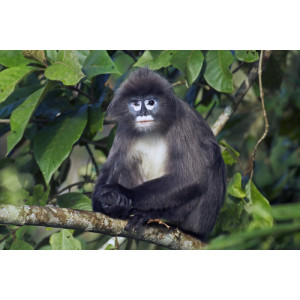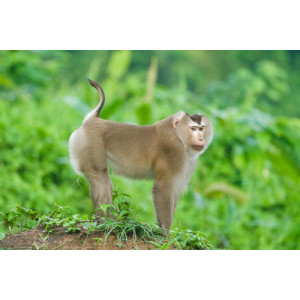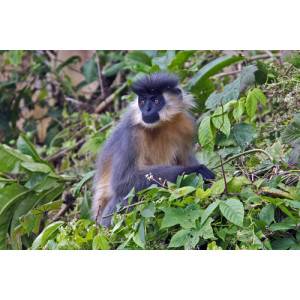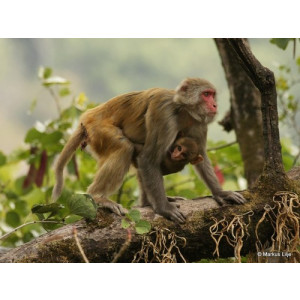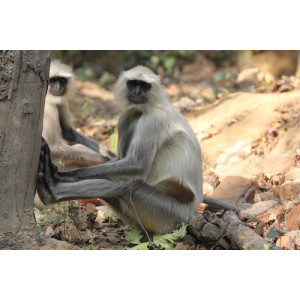Long-tailed Macaque Did you see this animal?
Scientific Name : Macaca fascicularis
Family : Cercopithecidae
Order : Primates
Class : Mammalia
Phylum : Chordata
Other Name : Crab-eating Macaque, Cynomolgus Monkey
Habitat : Forest
Description : Long-tailed macaque has olive brown coloured coat with Long-tailed macaques are medium-sized primates that typically weigh between 3 and 8 kilograms (6.6 to 17.6 pounds) and have a body length of 38 to 55 centimeters (15 to 22 inches). Males are usually larger than females.
They have a brownish-gray fur with a lighter underside and a long, slender tail, which can reach lengths of up to 50 centimeters (20 inches). They have a prominent brow ridge and cheek pouches that are used for storing food.
Long-tailed macaques are omnivorous and feed on a variety of plant materials, as well as insects, small animals, and even human food in urban areas.
They are social animals that live in groups of up to 50 individuals, with females usually outnumbering males. They have a complex social structure with dominance hierarchies, and individuals form strong social bonds with others.
Long-tailed macaques are found in a variety of habitats, including rainforests, mangroves, and urban areas. They are also known to inhabit agricultural areas and can cause crop damage, leading to conflicts with humans.
Long-tailed macaques are listed as a species of least concern by the International Union for Conservation of Nature (IUCN) due to their widespread distribution and adaptability to different habitats. However, they are often considered a pest species in urban and agricultural areas and can be subject to control measures.
underparts. The macaque has unusually shorter legs, long and prominent cheek whiskers; often with a crest on head.
They have a brownish-gray fur with a lighter underside and a long, slender tail, which can reach lengths of up to 50 centimeters (20 inches). They have a prominent brow ridge and cheek pouches that are used for storing food.
Long-tailed macaques are omnivorous and feed on a variety of plant materials, as well as insects, small animals, and even human food in urban areas.
They are social animals that live in groups of up to 50 individuals, with females usually outnumbering males. They have a complex social structure with dominance hierarchies, and individuals form strong social bonds with others.
Long-tailed macaques are found in a variety of habitats, including rainforests, mangroves, and urban areas. They are also known to inhabit agricultural areas and can cause crop damage, leading to conflicts with humans.
Long-tailed macaques are listed as a species of least concern by the International Union for Conservation of Nature (IUCN) due to their widespread distribution and adaptability to different habitats. However, they are often considered a pest species in urban and agricultural areas and can be subject to control measures.
underparts. The macaque has unusually shorter legs, long and prominent cheek whiskers; often with a crest on head.
Distribution in Bangladesh
References:
description written by: Asad U. Tanvir, Department of Zoology, Jagannath University, Dhaka; reviewed by: Muntasir Akash, Department of Zoology, University of Dhaka; Taxonomic Checklist: Red List of Bangladesh Volume 2: Mammals, 2015, IUCN; information sources: iucnredlist.org, Khan 2018 (Photographic guide to the wildlife of Bangladesh), photo credit: jorgejuanrueda(www.inaturalist.org/people/jorgejuanrueda), photo copyright: iNaturalist. For more information please contact with us.
description written by: Asad U. Tanvir, Department of Zoology, Jagannath University, Dhaka; reviewed by: Muntasir Akash, Department of Zoology, University of Dhaka; Taxonomic Checklist: Red List of Bangladesh Volume 2: Mammals, 2015, IUCN; information sources: iucnredlist.org, Khan 2018 (Photographic guide to the wildlife of Bangladesh), photo credit: jorgejuanrueda(www.inaturalist.org/people/jorgejuanrueda), photo copyright: iNaturalist. For more information please contact with us.

